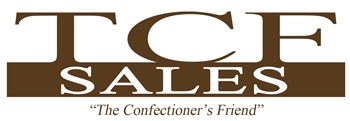Useful Information About Chocolate
If you are new to chocolate, here is some useful information that will assist you. Find basic industry terminology, melting and tempering techniques, working temperatures plus a Celsius to Farenheit Conversion Table, cooling and storing requirements, plus possible problems and causes to make corrections.
BASIC CHOCOLATE TERMINOLOGY:
- COUVERTURE CHOCOLATE: High quality chocolate (considered "real chocolate") that is processed for superior flavor and texture and is ideal for moulding and enrobing due to the amount of cocoa solids used that naturally contains cocoa butter (~50% of the mass), which makes it easier to work with, more nutritional, and results in a beautiful shine and "snap" when you bite into it. In the U.S., couverture chocolate must contain a minimum of 35% cocoa solids and a mimimum of 31% cocoa butter. A couverture chocolate will contain cocoa solids, cocoa butter and sugar, and can contain additives like vanilla, soy lecithin or milk powder. Learn about interesting new chocolate formulas.
- COMPOUND CHOCOLATE: A less expensive version of 'real' chocolate that includes a combination of cocoa, sweatners, and vegetable fat such as coconut oil or palm kernel oil. This type of chocolate does not require tempering (after melting) but also does not result in a superior shine or snap.
- CHOCOLATE SOFTENING POINT: When your chocolate softens; usually around 85° F.
- CHOCOLATE MELTING POINT: When your chocolate melts; usually around 93° F.
- CHOCOLATE TEMPERING: The process of transforming melted chocolate into a stabilized desired crystalized form that will result in proper hardness and gloss of the finished product after cooling, and will have a snap when it breaks. Properly tempered chocolate will release nicely from moulds (molds) and will not show signs of fat bloom or sugar bloom. Poor tempering of chocolate is characterized by a spotty surface, gray streaks, and / or a cheesy or crumbly texture and is typically difficult to release from moulds.
- CHOCOLATE VISCOSITY: The thickness or thinnesss of your chocolate.
- A rating of <100 is considered low viscosity
- A rating of 100 - 130 is considered medium viscosity
- A rating of 130 - 180 is considered high viscosity
- FAT BLOOM: A fuzzy white or gray haze caused by unstable fat crystals rising to the surface of your chocolate.
- SUGAR BLOOM: A slick syrup like substance forms when moisture is in contact with your chocolate and disolves the sugar and crystalizes when the moisture evaporates.
STORING CHOCOLATE: Chocolate is sensitive to temperature, humidity, light and odors, and should be properly stored. Room temperature should be constant, from 12° C to 20° C (54° - 68° F), and preferrably from 18° C to 20° C (65° to 68° F), with adequate ventilation. Boxes should be stores at least 4" from the floor and 4" away from the walls. Only store in a refrigerated area if very tightly sealed and take care to avoid temperature shock when removed, which can cause condensation. See additional infomation on chocolate storage.
WORKING WITH CHOCOLATE: Chocolate is delicate and can be temperamental if not properly handled.
- Ambient room temperature should be between 65°-70° F with a humidity level not to exceed 50%
- Prevent water, steam or moisture from coming into contact with your chocolate or tools
- Do not use wooden utensils to stir chocolate to prevent absorbtion of odors or moisture
- Melt LOW & SLOW
- Obtain a good temper
- Properly cool, store & handle
View a convenient Celsius to Fahrenheit Conversion Table, and learn more about obtaining good results.
CHOCOLATE MELTING: Chocolate will melt just below body temperature. It is very important to melt chocolate low and slow, stiring as needed to evenly distribute the heat. When handling chocolates, use thin cotton gloves to prevent finger print bloom.
CHOCOLATE TEMPERING: Chocolate is tempered with temperature, time and movement and can be accomplished on a cool (marble) work surface, in a melting pan or chocolate melter, with a wheel-type tempering machines, or in an automatic tempering machine. See more about tempering temperatures here. There is a lot of information on this. Contact us if you need a brochure explaining the manual methods. Micro-wave tempering of chocolate is possible but only recommended for a very small quantity.
CHOCOLATE COOLING: Chocolate should be cooled in a refrigerator from 60°-65° F, with good air circulation for even heat removal. Placing moulds (molds) on perforated trays for use with a refrigerator that accommodates standard pan sizes is ideal for productivity and circulation. Note: If your cooling is too cold, unstable fat crystals will occur and result in fat bloom. If too warm, random crystallization can occur due to poor heat removal and result in a crumbly texture. Cooling tunnels for chocolate confectionery typically have 3 temperature zones: Zone 1 is the loading zone that is the warmest at room temperature (65°-70° F), Zone 2 has an air flow of 55° - 60° F, and Zone 3 is slightly warmer at 65° - 68° F, to prevent condensation when leaving the tunnel.
|
PROBLEM |
CAUSE(S) |
| White or grey on chocolate |
|
| Dull marks on product |
|
| Cracks appear on product |
|
| Difficult to remove from moulds |
|
| Product not glossy |
|
| Chocolate thickens during use |
|
| Fingerprints on product |
|
